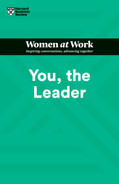Since the Women at Work podcast first launched, we’ve heard from all over the world that it has inspired discussions and listening groups. We hope that this book does the same—that you’ll want to share what you’ve learned with others. The questions in this discussion guide will help you talk about the challenges women face in the workplace and how we can work together to overcome them.
You don’t need to have read the book from start to finish to participate. To get the most out of your discussion, think about the size of your group. A big group has the advantage of spreading ideas more widely—whether throughout your organization or among your friends and peers—but might lose some of the honesty and connection a small group would have. You may want to assign someone to lead the discussion to ensure that all participants are included, especially if some attendees are joining virtually. And it’s a good idea to establish ground rules around privacy and confidentiality. Women at Work topics touch on difficult issues surrounding sexism and racism, so consider using trigger warnings.
Finally, think about what you want to accomplish in your discussion. Do you want to create a network of mutual support? Hope to disrupt the status quo? Or are you simply looking for an empathetic ear? With your goals in mind, use the questions that follow to advance the conversation about women at work.
- What leadership traits are valued in your organization? Do you feel these are a fair representation of what both men and women can bring to the table? What are some of the double binds you’ve faced as you’ve pursued promotions and leadership positions?
- In chapter 1, Nicole asks Tina Opie what the difference is between being inauthentic and being pushed out of your comfort zone. As you think about becoming a leader, how would you answer this question?
- Think back to an instance where you were angry or frustrated at work. How did you respond? Did your reaction help or hurt the situation, and what would you do differently next time? How are strong emotions generally handled in your workplace?
- In chapter 5, Muriel Maignan Wilkins and Amy Jen Su describe the first time they were seen as leaders. Have you had a moment when you were first seen as a leader—formally or informally? Who saw you as that leader, and what did they say or do that conveyed that feeling to you?
- What are the largest struggles you’ve faced as you work to embody leadership presence and develop your leadership voice? How have others responded to you?
- What are the qualities you want in a sponsor? If you have a sponsor, how did you ask the person to take on that role, and what are some ways that you work together productively? If you don’t have a sponsor, what are some of the barriers you’re facing in securing this relationship?
- In chapter 10, Amy Jen Su says we need to stop thinking that claiming credit is the same as bragging or self-promotion—something to feel “icky” about—and start seeing it as taking ownership of our work. How have you advocated for yourself in the past? Has someone ever stolen credit for your work? How did you respond? What would you do differently now?
- Describe a time when you discussed promotion and growth opportunities with your boss. Was your boss supportive? What worked in that conversation—and what didn’t?
- In chapter 13, Cindy Pace describes the difficult path for women of color as they aspire to leadership positions. If you’re a woman of color, did you relate to what she says, and have you tried any of these tactics? If you’re not a woman of color, what have you observed in your own organization with regard to intersectionality and leadership?
- In chapter 15, Shannon Huffman Polson shares some harsh statements that her army superiors said to her—that the army doesn’t owe her anything and she’ll be married by the time she’s 25. Have you heard similar comments in your own career? How have you rebounded from such statements and attitudes?
- What does the leadership team at the top of your organization look like? Is there diversity reflected in the group? Do you see opportunities for you to grow into leadership there, based on what you see?
- Are the ways that promotion and leadership decisions are made in your organization fair? Where do you see them falling short? What is one way you can encourage the organization to change?
- What specific skills are required for leaders in your organization, according to your HR department or recent job descriptions? What are ways you can develop these skills, inside and outside of work?
- How can men be better supporters of women? What should they stop doing? And what can they do more of?
- What are relationships like between women at your office? What are ways you’ve seen women support each other—and what are other ways you can do the same?
